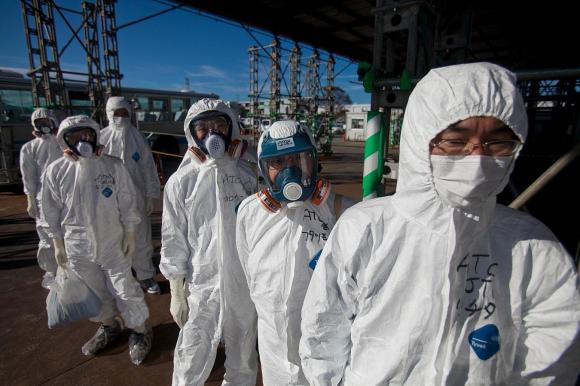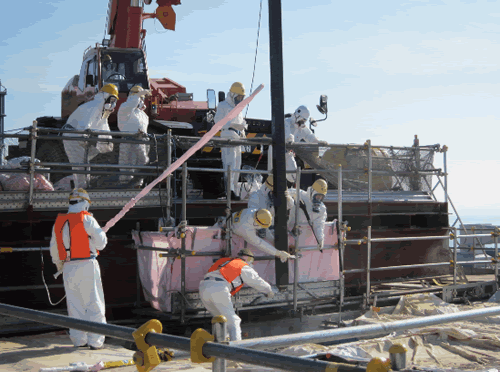
It has come to light that the Japanese government’s Fukushima Daiichi cleanup plan is failing due to problems concerning counterfeit contracts. The government is now left reassessing its human resource strategy and considering how to effectively secure the number of employees required to carry out the work. As it presently stands, more than half of the laborers employed at the nuclear site are suspected of being involved in counterfeit contract work.
Termed as the ‘working schedule’, the plan to disassemble and decommission the Daiichi Nuclear Power Plant was finalized by the government and Tokyo Electric Power in July last year. It was estimated at the time that a workforce of around 12,000 would be required to effectively carry out operations at the plant, and that by the year 2016 any possible shortages in working numbers would be resolved.
Up until May last year, the designated number of employees qualified to work with radioactive materials was estimated at a total of 24,300. Excluding personnel exposed to high levels of radiation through onsite work, the number of laborers deemed suitable to re-engaged in work once their designated contract had come to a close was 23,300. It was stated by the government that this number would be sufficient in steering the work at Daiichi towards a state of completion.
However, what alerted the government to a serious problem were the results of a questionnaire conducted by Tokyo Electric Power that asked 4,000 workers at the plant about their working conditions, asking:
“Is the company providing you with daily instruction the same as that which pays your salary?”
In response to which, an astounding 47 percent of staff replied that the company that paid their salary was not the same as that which organised workers and provided instructions. The situation appears to be that the original subcontractors are in turn subcontracting work to other groups or workers. The cycle is then being repeated, giving rise to a multiple subcontract working system where it is difficult to know who is really in charge. While the original subcontractor might well be operating legally, with multiple subcontracts overlapping in this way, the practice of passing designated work down from subcontractor to subcontractor ultimately creates a breeding ground for unscrupulous activity.
With the situation as it stands, the Ministry of Trade and Industry (METI) admits that securing the required workforce is becoming a difficult task. METI announced that at some point before June 2013, it will be looking to revise the work policy at the plant. What compounds problems further is that the radiation exposure levels of many workers far exceed those being officially recorded.
Ministry representative Kentaro Funaki, who is working on the resolution of the nuclear disaster, comments:
“An improvement in labor conditions is essential. Only by reconsidering the working strategy and looking at ways to improve it, will it be possible to secure the necessary labor force to bring the work at Daiichi nuclear power plant to an end.”
Source: Yaho0! Japan ニュース
Header image: nanohana.me Inset image: blog.goo.ne.jp

 First worker to die from Fukushima radiation exposure officially recognized by Japan’s government
First worker to die from Fukushima radiation exposure officially recognized by Japan’s government Take a tour of the Fukushima Daiichi Nuclear Power Plant seven years after the disaster 【Video】
Take a tour of the Fukushima Daiichi Nuclear Power Plant seven years after the disaster 【Video】 Japan government makes cute illustrated version of radioactive isotope it plans to dump into sea
Japan government makes cute illustrated version of radioactive isotope it plans to dump into sea TEPCO in hot water for use of tasteless hashtag in recent tweet about Fukushima Nuclear Plant
TEPCO in hot water for use of tasteless hashtag in recent tweet about Fukushima Nuclear Plant U.S. military personnel launch US$5 billion lawsuit against Tokyo Electrical Power Company
U.S. military personnel launch US$5 billion lawsuit against Tokyo Electrical Power Company Foreigner’s request for help in Tokyo makes us sad for the state of society
Foreigner’s request for help in Tokyo makes us sad for the state of society Japanese city loses residents’ personal data, which was on paper being transported on a windy day
Japanese city loses residents’ personal data, which was on paper being transported on a windy day Suntory x Super Mario collaboration creates a clever way to transform into Mario【Videos】
Suntory x Super Mario collaboration creates a clever way to transform into Mario【Videos】 Red light district sushi restaurant in Tokyo shows us just how wrong we were about it
Red light district sushi restaurant in Tokyo shows us just how wrong we were about it Heartwarming response to Twitter question confirms that yes, Tikuwa_0913, there is a Santa Claus
Heartwarming response to Twitter question confirms that yes, Tikuwa_0913, there is a Santa Claus Akihabara pop-up shop sells goods made by Japanese prison inmates
Akihabara pop-up shop sells goods made by Japanese prison inmates Harajuku Station’s beautiful old wooden building is set to return, with a new complex around it
Harajuku Station’s beautiful old wooden building is set to return, with a new complex around it Sandwiches fit for a sumo served up in Osaka【Taste Test】
Sandwiches fit for a sumo served up in Osaka【Taste Test】 Tokyo Tsukiji fish market site to be redeveloped with 50,000-seat stadium, hotel, shopping center
Tokyo Tsukiji fish market site to be redeveloped with 50,000-seat stadium, hotel, shopping center Starbucks Japan adds a Motto Frappuccino to the menu for a limited time
Starbucks Japan adds a Motto Frappuccino to the menu for a limited time McDonald’s new Happy Meals offer up cute and practical Sanrio lifestyle goods
McDonald’s new Happy Meals offer up cute and practical Sanrio lifestyle goods Japanese ramen restaurants under pressure from new yen banknotes
Japanese ramen restaurants under pressure from new yen banknotes French Fries Bread in Tokyo’s Shibuya becomes a hit on social media
French Fries Bread in Tokyo’s Shibuya becomes a hit on social media Studio Ghibli releases new action figures featuring Nausicaä of the Valley of the Wind characters
Studio Ghibli releases new action figures featuring Nausicaä of the Valley of the Wind characters New private rooms on Tokaido Shinkansen change the way we travel from Tokyo to Kyoto
New private rooms on Tokaido Shinkansen change the way we travel from Tokyo to Kyoto All-you-can-drink Starbucks and amazing views part of Tokyo’s new 170 meter-high sky lounge
All-you-can-drink Starbucks and amazing views part of Tokyo’s new 170 meter-high sky lounge Beautiful Ghibli sealing wax kits let you create accessories and elegant letter decorations【Pics】
Beautiful Ghibli sealing wax kits let you create accessories and elegant letter decorations【Pics】 Studio Ghibli releases Kiki’s Delivery Service chocolate cake pouches in Japan
Studio Ghibli releases Kiki’s Delivery Service chocolate cake pouches in Japan New definition of “Japanese whiskey” goes into effect to prevent fakes from fooling overseas buyers
New definition of “Japanese whiskey” goes into effect to prevent fakes from fooling overseas buyers Our Japanese reporter visits Costco in the U.S., finds super American and very Japanese things
Our Japanese reporter visits Costco in the U.S., finds super American and very Japanese things Studio Ghibli unveils Mother’s Day gift set that captures the love in My Neighbour Totoro
Studio Ghibli unveils Mother’s Day gift set that captures the love in My Neighbour Totoro More foreign tourists than ever before in history visited Japan last month
More foreign tourists than ever before in history visited Japan last month New Pokémon cakes let you eat your way through Pikachu and all the Eevee evolutions
New Pokémon cakes let you eat your way through Pikachu and all the Eevee evolutions Sales of Japan’s most convenient train ticket/shopping payment cards suspended indefinitely
Sales of Japan’s most convenient train ticket/shopping payment cards suspended indefinitely Sold-out Studio Ghibli desktop humidifiers are back so Totoro can help you through the dry season
Sold-out Studio Ghibli desktop humidifiers are back so Totoro can help you through the dry season Japanese government to make first change to romanization spelling rules since the 1950s
Japanese government to make first change to romanization spelling rules since the 1950s Ghibli founders Toshio Suzuki and Hayao Miyazaki contribute to Japanese whisky Totoro label design
Ghibli founders Toshio Suzuki and Hayao Miyazaki contribute to Japanese whisky Totoro label design Doraemon found buried at sea as scene from 1993 anime becomes real life【Photos】
Doraemon found buried at sea as scene from 1993 anime becomes real life【Photos】 Tokyo’s most famous Starbucks is closed
Tokyo’s most famous Starbucks is closed One Piece characters’ nationalities revealed, but fans have mixed opinions
One Piece characters’ nationalities revealed, but fans have mixed opinions We asked a Uniqlo employee what four things we should buy and their suggestions didn’t disappoint
We asked a Uniqlo employee what four things we should buy and their suggestions didn’t disappoint Princesses, fruits, and blacksmiths: Study reveals the 30 most unusual family names in Japan
Princesses, fruits, and blacksmiths: Study reveals the 30 most unusual family names in Japan Meet the the 90-year-old Japanese woman who is McDonald’s Japan’s oldest female employee
Meet the the 90-year-old Japanese woman who is McDonald’s Japan’s oldest female employee Japan’s ‘agri-tech’ farming revolution
Japan’s ‘agri-tech’ farming revolution Haruki Murakami’s solution to the nuclear power debate in Japan: Actually call it “nuclear power”
Haruki Murakami’s solution to the nuclear power debate in Japan: Actually call it “nuclear power” Fukushima bottled water wins Gold Quality Award in the internationally coveted Monde Selection
Fukushima bottled water wins Gold Quality Award in the internationally coveted Monde Selection U.S. military in Japan bulk buys Japanese scallops as China’s Japanese seafood ban continues
U.S. military in Japan bulk buys Japanese scallops as China’s Japanese seafood ban continues Pet crematorium in Japan was burning trash with animals for more than 10 years
Pet crematorium in Japan was burning trash with animals for more than 10 years The number of elderly people in Japan this year has yet again smashed multiple records
The number of elderly people in Japan this year has yet again smashed multiple records The dirty reason China can’t always tell North Korea what to do
The dirty reason China can’t always tell North Korea what to do New species of mayfly discovered in Fukushima that can never get their prescription glasses
New species of mayfly discovered in Fukushima that can never get their prescription glasses Nearly five percent of Japanese are addicted to gambling – even though it’s still “illegal”
Nearly five percent of Japanese are addicted to gambling – even though it’s still “illegal” Japan now has over 40,000 foreign convenience store clerks as it continues to internationalize
Japan now has over 40,000 foreign convenience store clerks as it continues to internationalize Strong earthquake hits Hokkaido in Japan, dozens missing and injured
Strong earthquake hits Hokkaido in Japan, dozens missing and injured Japanese companies want to monitor employees working overtime using in-office flying drones
Japanese companies want to monitor employees working overtime using in-office flying drones Lawson announces new human-controlled digital avatars at store registers starting this fall
Lawson announces new human-controlled digital avatars at store registers starting this fall Government study finds only 3,065 homeless people in Japan
Government study finds only 3,065 homeless people in Japan Overworked Japan celebrated Labor Day on a Saturday this year
Overworked Japan celebrated Labor Day on a Saturday this year
Leave a Reply